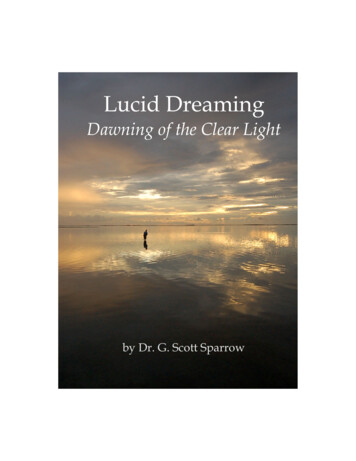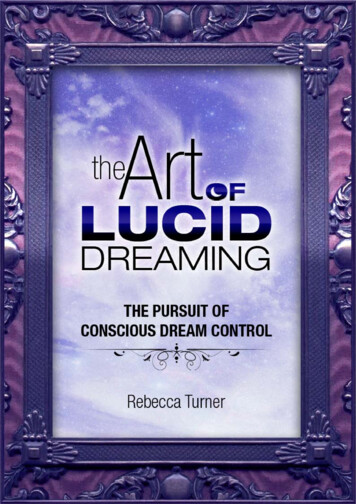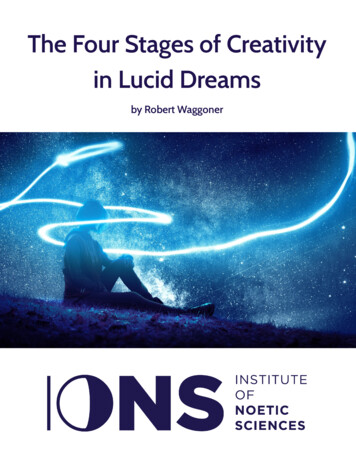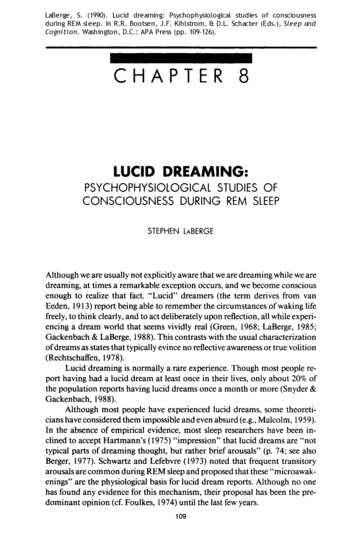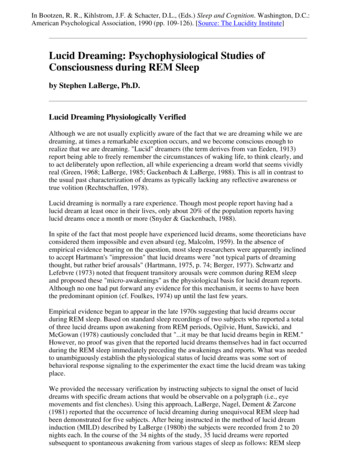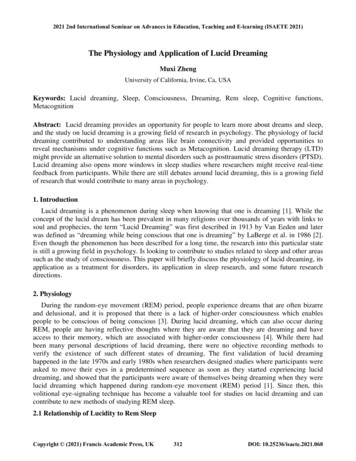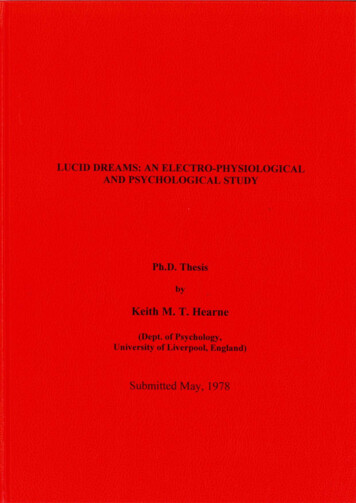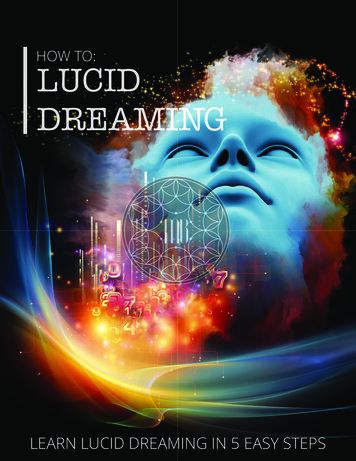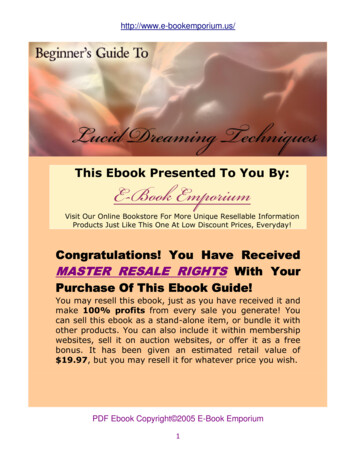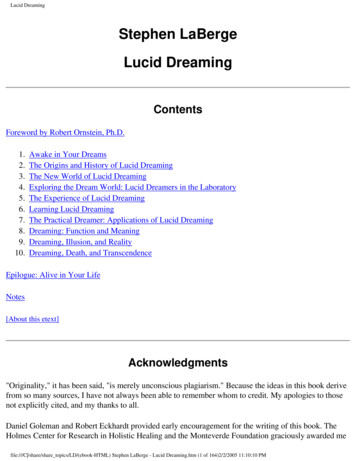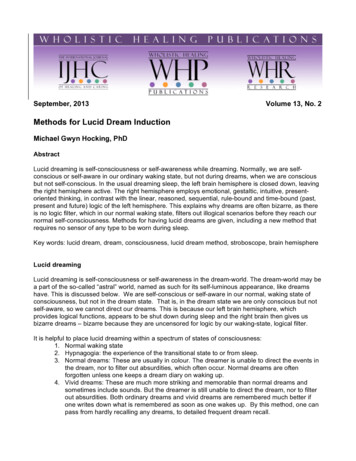
Transcription
September, 2013Volume 13, No. 2Methods for Lucid Dream InductionMichael Gwyn Hocking, PhDAbstractLucid dreaming is self-consciousness or self-awareness while dreaming. Normally, we are selfconscious or self-aware in our ordinary waking state, but not during dreams, when we are consciousbut not self-conscious. In the usual dreaming sleep, the left brain hemisphere is closed down, leavingthe right hemisphere active. The right hemisphere employs emotional, gestaltic, intuitive, presentoriented thinking, in contrast with the linear, reasoned, sequential, rule-bound and time-bound (past,present and future) logic of the left hemisphere. This explains why dreams are often bizarre, as thereis no logic filter, which in our normal waking state, filters out illogical scenarios before they reach ournormal self-consciousness. Methods for having lucid dreams are given, including a new method thatrequires no sensor of any type to be worn during sleep.Key words: lucid dream, dream, consciousness, lucid dream method, stroboscope, brain hemisphereLucid dreamingLucid dreaming is self-consciousness or self-awareness in the dream-world. The dream-world may bea part of the so-called “astral” world, named as such for its self-luminous appearance, like dreamshave. This is discussed below. We are self-conscious or self-aware in our normal, waking state ofconsciousness, but not in the dream state. That is, in the dream state we are only conscious but notself-aware, so we cannot direct our dreams. This is because our left brain hemisphere, whichprovides logical functions, appears to be shut down during sleep and the right brain then gives usbizarre dreams – bizarre because they are uncensored for logic by our waking-state, logical filter.It is helpful to place lucid dreaming within a spectrum of states of consciousness:1. Normal waking state2. Hypnagogia: the experience of the transitional state to or from sleep.3. Normal dreams: These are usually in colour. The dreamer is unable to direct the events inthe dream, nor to filter out absurdities, which often occur. Normal dreams are oftenforgotten unless one keeps a dream diary on waking up.4. Vivid dreams: These are much more striking and memorable than normal dreams andsometimes include sounds. But the dreamer is still unable to direct the dream, nor to filterout absurdities. Both ordinary dreams and vivid dreams are remembered much better ifone writes down what is remembered as soon as one wakes up. By this method, one canpass from hardly recalling any dreams, to detailed frequent dream recall.
25. Lucid dreams: One becomes self-conscious, just like in one’s waking state, and have theability to consciously direct the unfolding of the dream process. The dreamer is fully selfconscious or self-aware and can direct the course of the dream. A lucid dream may bequite short, such as perceiving oneself in another room in one’s house which is bright as ifin full daylight, even though the actual time may be midnight. One can look around theroom at one’s own will. A lucid dream may end abruptly, with loss of consciousness.Vivid dreams transition only rarely to lucid dreams. A lucid dream is accompanied by asudden feeling of exhilaration, which a vivid dream does not have. The mind continues tocreate or add hallucinatory images to both types of dreams.6. Out of body experiences (OBEs): One may observe one’s physical body, lying asleep.OBEs may also occur when under anaesthesia and after brain injury. They can sometimesalso be a part of “near death experiences” (NDEs).7. Inspirational flashes of intuition for problem-solving: In dreams that provide solutions toproblems the dreamer has been pondering, we often have the factual report of the imagesand actions that appeared in the dream which provided answers to previously unsolvedchallenges. Rarely are there clear indications that the dreamer volitionally directed thedream towards the solution, or in any other way directed other portions of the dream sothat the dream could be identified with reasonable certainty as a lucid dream. In many ofthese cases, however, the person had a strongly held compelling desire to find a solutionto a problem prior to entering the dream state. In some cases the quest for an answer hadbeen present for months or even years. The reports of these dreams containing creativesolutions were clearly very helpful and even inspirational to the dreamers. In this respectthey demonstrate some of the qualities of a lucid dream.8. Past life memories.Everyone experiences the first four states, but lucid dreams are very rare unless one takes steps toinduce them.The different states of consciousness listed above can sometimes overlap as mixed experiences. Forinstance, hypnagogia may involve no imagery, but has been variously described as characterised byvisions of half-sleep, ‘faces in the dark’, ‘oneiragogic images,’ etc. (Mavromatis, 2010).An example of a vivid dream transitioning into a lucid dream is given by Celia Green (1968) in herclassic book on lucid dreaming. It begins as a vivid dream that turns into a lucid dream. She quotesfrom Delage (1919):I find myself in Paris, on Rue Soufflot, where it meets Boulevard Saint-Michel. I am standingon the pavement, which is on one’s right when going towards the Pantheon and I am lookingtowards the other side of the road, where I see an enormous second-hand bookshop. Longcounters stretch along the shop-front under arcades, and there are assistants perched onladders arranging the books. On the ground between the pillars there are tables loaded withbooks, and there are passers-by browsing through them and even people sitting to read. I lookat this spectacle with a certain surprise, but without remembering in my dream that this is notin accord with reality. I know very well that in that position there is no second-hand bookshopbut a large café. But in my dream I do not remember this.I move away, and a short distance away on the boulevard, between the street corner and theMedici fountain, I join a group of loiterers who are gathered around a contortionist. At thismoment I become analytical. I remember coming to Paris the day before, which was aSaturday, and it occurs to me that the next day, Monday, I shall come again to Paris, as usual,for the meeting of the Academy. And from this I conclude that today is a Sunday. Then I say tomyself, ‘How is it that I came here on a Sunday? This is hardly ever the case.’ And at once it
3dawns on me: ‘ If it is Sunday and I think I am in Paris, I must be dreaming.’ The dreamimmediately becomes completely lucid, without losing any of its hallucinatory character norany of its vividness.Thus, the consideration that brought me to the conviction I was dreaming was not the weightyargument that the corner of the Rue Soufflot seems to be occupied by a shop which (in reality,but not in my dream, for the memory does not occur to me) I know very well is not there, but inthis very feeble argument I find myself in Paris on a day when I am not usually there.Celia Green (1968) gives many typical lucid dream examples. She comments it may be hard toclassify whether one is experiencing a lucid dream or an OBE. An example is given below.Oliver Fox (1968) asked a friend to appear in his room during a dream and reports:“The following evening we met and I found Elsie very excited and triumphant. ‘I did come toyou!’ she greeted me. ‘I really did. I went to sleep willing that I would, and all at once I wasthere! This morning I knew just how everything was, in your room, but I’ve been forgetting it allday – it’s been slipping away.’ She described in detail the following:(i)Relative positions of door, bed, window, fireplace, wash-stand, chest of drawers,dressing table.(ii)The window had some small panes instead of the usual larger ones.(iii)That I was lying, eyes open, on the left side of a double bed and seemed dazed.(iv)An old-fashioned pin cushion, unusual for a man’s room.(v)A black Japanese box covered with red raised figures.(vi)A leather-covered desk lined with gilt, sunk plate on top for handle to fall back into,standing on the chest of drawers. She described how she was running her fingersalong a projection ridge on the front of this desk.”Green adds:It is of interest that Fox initially thought that the last of these details was incorrect, and thatwhat the subject had taken for a projecting ridge was merely a gilt line on the leather.However, having asserted that there was no projecting ridge anywhere on his desk, he laterdiscovered that Elsie was correct: Fox noted: “The desk was placed to front the wall, and thehinges (which I had quite forgotten) made a continuous projecting gilt ridge just as she haddescribed. Owing to its position she had naturally mistaken the back of the desk for the front.”Here is another short example from Green, classed as a lucid dream:Dreaming that I was walking along a road – straight and I think walled on one side – I realisedI was dreaming. I knew this was a thing I had been trying to do and thought, ‘Now I can makesomething happen’. I thought I would like to have an apple. I saw a patch on the road aheadand thought, ‘By the time that I reach that, it will be an apple’. Before reaching it, I found I hadanother apple in my hand. I examined it, thinking, ‘Quite a creditable imitation of an apple’.Lamberton, in a state of hypnagogia at the end of a sleep, had a lucid vision of a blackboard ofgeometric drawings on it, which solved a problem he had been trying to solve by a different method.This is an example of a vivid vision/dream from which a scientific proof (invention) arose. Anotherexample is that of the mathematician Poincare who invented Fuschian Functions. Probably they werestill in a dream-type of mental state as they awoke, or they would not have seen these in avision/image, for example as a blackboard.
4It seems most promising to develop a state which may expand one’s faculties in ways that are beyondnormal self-consciousness, as an exploratory quest, perhaps even leading to out of the bodyexperiences (OBEs). While associations are sometimes noted between lucid dreams and OBEs, adiscussion of the link between these is beyond the scope of this paper and for more on this the readeris referred to Yushak (2009) and Green (1968).Methods for deliberately entering a lucid dreaming stateVarious mind-body methods have been employed to induce a lucid dreaming state.Non-electronic methods1. A fast, easy method to achieve lucid dreams is to use a flotation tank (Hutchison, 1984), but mayrequire several sessions. This is typically an 8 ft x 4 ft tank holding 10 inches of nearly saturatedsolution of magnesium sulphate (BP or USP grade), at 35 degrees C (skin temperature). This createsan ambience where there is no sense of touch. The room is dark and soundproof, so all five sensesreceive no normal input. This causes the brain to “turn up its automatic gain control”, which bringsforward normally-subliminal inputs into one’s consciousness – a very unusual state to be in. Also, anelectroencephalograph (EEG) trace shows that bi-laterally symmetrical beta, alpha and thetabrainwaves are spontaneously produced, normally associated with advanced meditation. After lessthan an hour, spontaneous bright images may appear, like a vivid dream, except that one is fullyawake and self-conscious. These may be scenes from long-past memories, or cartoon characters.Several sessions may be needed to reach this state. Some call this a “WILD” (Waking-state InducedLucid Dream).A flotation-tank-induced state of consciousness has a wide range of uses, including achieving selfhypnosis for difficult subjects; pain relief (e.g., arthritis) achieved by endorphin release caused by thetank experience; super-leaning for students, used, for example, by lawyers preparing mentally forcourt case presentations and used by baseball team members before a game; improving athleticperformance; reducing smoking and drug use; achieving weight-loss; giving access to the right-brainfor creativity and enhancement of inventiveness; reducing stress and anxiety; and it appearsbeneficial in prevention of heart disease (Hutchison, 1984).2. A simple method, needing no equipment, is to look at one’s hands very frequently throughout theday and try to make them disappear, as a test of whether one is awake or dreaming. If this simple testis made habitual by being done very frequently during the day (which is surprisingly difficult toremember to do!), this will then automatically be continued during dreams but then one’s hands willdisappear and this will trigger a realisation that one is dreaming, and at that moment of selfconsciousness the dream may become lucid. Through this process, one is inviting the left hemisphereto become active during dreaming. The dream can then be consciously directed.A simpler variant is just to look at one hand frequently during the day and then, when going to sleep,decide to do the same in any dream. This action can trigger a lucid dream.Another similar daytime exercise is to continually ask if one is dreaming or not by looking away andback again and see if the scene has changed. If it has, you are dreaming.Other such trigger methods are described in books on lucid dreaming by the Lucidity Institute (LaBergeand Rheingold, 1990; Levitan and LaBerge, 1993).3. Namkhai Norbu (1992) describes a retreat into a dark room for two or three days, which has beenused by western psychologists to produce vivid dreams. But the same production of visual imagery
5can be obtained in hours instead of days by using a flotation tank, described in (1) above. See alsoAppendix C.Electronic methods1. The “Dreamlight” (Lucidity, web reference) utilizes a face mask containing LEDs which flash whendreaming is detected by rapid eye movements (REM). This series of flashes alerts the dreamer,within the dream, that he/she is dreaming, and this can trigger self-awareness. However, wearing aface mask has the disadvantage that it may be hard to sleep while wearing it.2. A thermistor (a resistor that changes with temperature) is taped to a nostril to monitor breathingrate. Its resistance varies with temperature. One’s in-breaths are colder than out-breaths. One’sbreathing frequency increases during dreaming sleep, triggering a frequency meter to send tinyelectric shocks to the sleeper’s wrist, or to flashes of a bright strobe lamp. The dreamer perceives theflashes in the dream as part of the dream, and then realises he is dreaming and a lucid dream is thustriggered. People with epilepsy should not use the strobe flashing method because it can precipitateseizures.3. A simple lucid dreaming method is to make a recording of fifteen minutes of silence, followed byone’s voice saying, “This is a dream. You are dreaming.” If this is played late at night when one issleepy and seated in an easy chair, one may fall into hypnagogia within fifteen minutes and this maytransfer into a lucid dream. A free program called “Audacity” to make this recording, is available fromAudacity (web reference) and the recording can be copied to an I-pod or other recording device andlistened to with earphones. In addition, earphones may be uncomfortable in bed, but perfectly alrightwhen sitting in an easy chair.4. Applications ("Apps") are now available on the I-pod Touch and I-phone, which wake one up duringrapid eye movement (REM) sleep - the best state for lucid dreams.a. One App is called "Sleep Cycle Alarm Clock" and is meant to wake you up only during a dream,giving a better wake-up feeling than an ordinary alarm clock, which may wake you in non-dreamingdeep sleep and can leave you feeling disgruntled. This App detects dreaming sleep from the fact thatone moves position slightly when dreaming, and then it sounds an alarm. Instead of using theprogrammed audible alarm, which would just wake one up, the output socket on the I-pod Touch canbe taken off as in Figure 1 and used as shown in Figures 2 and 3 to trigger lucid dreams. (See furtherdetails and explanations in Appendix B, and the Sleep Cycle Alarm Clock display in Figure 5.)For the Sleep Cycle Alarm Clock, the I-pod Touch can be used to detect REM sleep by using theaccelerometer which is built into an I-pod Touch or an I-phone. This allows dreaming to be detectedwith nothing worn on the face and no sensor connected anywhere on the person while sleeping.Nothing is in contact with the body. This is a very major advantage, as one can sleep quite normally,unencumbered by attached sensors. The author of this article found the system works well for itsuser. A potential drawback is the use of strobe light flashes, but in this case another person sleepingnearby was not disturbed by the light flashes. (See Appendix B, Figure 2 for the strobe setup.)b. An alternative to a strobe for the same method is to use a device intended as a “Snore Stopper”which can also be run from an I-pod. The type tested by the author is shown in a separate article(Hocking, web reference). It is worn like a wristwatch and is less convenient than the strobe, becauseit requires a sensor to be worn. The only advantage of the snore stopper method is that it would notcause epileptic seizures. When the I-pod is triggered by REM sleep, its signal can power either thestrobe or the “snore stopper” device. The latter has an electret microphone which is meant to pick upsounds of snoring that persist for more than about 8 seconds, and then it delivers tiny electric shocksto the wrist, which rouses the snorer just enough to make him/her stop snoring, but without waking
6him/her up. This has been found to alert a dreaming sleeper sufficiently to become lucid in his/herdream.Herbal methods for lucid dreamsThe author has found that if one eats a vegetarian dish in the evening called Lo Han (“Buddha’sdelight”) with soy sauce, available in some Chinese Restaurants, one may have unusually vividdreams in that night. The constituents of this dish, listed in Google, include lily buds and soy sauce.Lily contains galantamine, which is known to cause lucid dreams. Choline or Alpha GPC mayenhance this effect. In the author’s experience, there are no effects during the day in the normalwaking state, so this seems to be a morally acceptable herb/drug in that it is non-addictive and will notalter the user’s behaviour in any ways that may affect others.The extract from plantation-grown Red Spider Lily (Lycoris radiata) has a long history as an herbaltreatment. For thousands of years people have used it for dream enhancement, as a headachetreatment and for its positive effect on memory recall.An herbal extract from the common snowdrop plant has long been used for improving memory inEastern Europe. In experiments for the USA Food and Drug Administration (FDA), a synthetic versionof this extract known as galantamine improves the memory of those with Alzheimers disease. Thesestudies revealed an odd side effect, namely that those in the study reported significantly more dreamsand enhanced dream recall. (See Appendix A for further practical details on the use of Galantamine.)Other methodsThe author has experienced what were undistinguishable from lucid dreams but which also seemedlike OBEs, leading me to suggest that the dream state involves some aspect of the astral. Onreturning from Hawaii to the UK, the author had considerable jet lag and while waking from the firstnight’s sleep back in the UK, the author’s bedroom appeared as it is, except that garlands of flowerswere hanging on the walls. The field of view was a full 360 degrees, but at the instant of waking, thefield of view snapped back to the normal 170 degrees and the garlands vanished.Sleeping at unusual times has been cited as a method for lucid dream induction, such as getting up atthe usual time in the morning and then going back to bed to sleep again (LaBerge & Rheingold,1980).The following reports are included on a possible link between OBEs and lucid dreams. On such alink, see also Green (1968) who says lucid dreams are closely related to OBEs and gives manyexamples, and Yuschak (2009).Appolonius of Tyana (Hocking, 2011) wrapped wool around himself to obtain out-of-the-bodyexperiences (OBEs), which possibly relates to one of the flotation tank features of making theenvironment temperature equal to the skin temperature. A flotation tank (Hocking, 2011) can producespontaneous “WILDs” (wake induced lucid dreams) but this is beyond the scope of this paper.It is also reported that wrapping oneself up completely like an Egyptian mummy, also causes out-ofthe-body experiences.Ashcroft-Nowicki (1980s) recommends that we might use the following exercise: Imagine an oldwooden door, with massive hinges (which will appear – depending on the depth of one’s degree ofvisualisation). Through the doorway you see a wild moorland on one side and on the other side a setof cliffs, washed by a grey wind-swept sea. You exit and lock the door behind you, placing the key inyour pocket. A detailed “pathworking” journey follows. Ancient archetypal paths can be used, defined
7by scenes on Tarot cards (for example, Tarot trump card XXI is an “astral doorway” – a path betweenMalkuth (Earth) and Yesod (“Astral”) in Kabbalistic terms (Z’ev ben Shimon Halevi [Warren Kenton],1979). After such journeys, return through the door and lock it behind you. It is important to ensurethat you are fully back in your own space and time (Hocking, 1993). Surprising revelations from yoursubconscious may be obtained by this method.See also references (Hocking, 1993; and Hocking, web reference) for more information on brainhemisphere activity, EEG usage, biofeedback, light and sound devices, cranial electrical stimulators,Ganzfeld, pathworking, and flotation tanks and for a free download of related information by theauthor.Inspirations during dream states of various sortsAn indication that a hypnagogic state (which is the precursor of the full sleep state) can yield valuableapplied results is evidenced by a procedure used by Thomas Edison, who was an incredibly prolificinventor. He used to relax in an easy chair while holding a rubber ball in his hand, and dozed towardssleep. Falling asleep caused him to release the ball, which then fell onto a metal sheet on the floorthat caused a noise sufficient to jar his consciousness enough for him to bring into his waking statemany ideas for inventions. I would speculate that Edison’s method may have led him into the thetabrainwave dream-state which has many possibilities for creative consciousness. Cade and Coxhead(1989), using the Mind Mirror EEG (web reference), found that theta brainwaves increased inamplitude in the hypnagogic and dreaming states. Theta brainwaves (about 6 Hz) are associated withdreaming and meditative states, and are produced by experienced meditators but are absent in thenormal waking state. Edison developed over a thousand inventions that were patented, many of whichhe obtained by his above special hypnagogic relaxation method, which he had devised for thatpurpose.It is not known if Edison’s hypnagogic reveries came only as ideas or as dream imagery, but manyothers report distinct imagery during hypnagogic states, which generated important literary andscientific contributions. Of note is Coleridge’s “Kubla Khan”; in writing this, Coleridge experienced adaydream in which ‘all the images rose up as things’ (Koestler, 1981).Poems, ideas for novels and entire novels have arisen in hypnagogic states (Mavromatis, 2010).Emily Bronte describes hypnagoic imagery in writing Wuthering Heights and Villette (Mavromatis,2010). Charles Dickens derived many of his stories during hypnagogia, but it is not known if thisgenerated ideas only, or imagery (Mavromatis, 2010). The author F. Miller (1906) describes in detailhow a novel arose, with her eyes closed, from imagery involving the Incas (Mavromatis, 2010).Jean Cocteau, on waking, visualised a play, as if he were watching it in a theatre, which he laterpublished as “The Knights of the Round Table” (Mavromatis, 2010). Mavromatis gives many othersuch examples of dreaming, sometimes lucid dreaming, of material useful for various purposes.Other examples are given by Green & Green (1977), but too detailed to summarise here.Probably the best-known example of a dream-state which yielded valuable scientific information wasthat of the organic chemist, Friedrich Kekule, who reported, “I fell into a reverie, and lo!, the atomswere gambolling before my eyes I saw how, frequently, two smaller atoms united to form a pair,how a larger one embraced two smaller ones I saw the larger ones form a chain I spent part ofthe night putting on paper the sketches of these dream forms.” Kekule had a series of such visions,the most famous one being on the ring structure of benzene. He did not ‘direct’ the dream, nor usethe term ‘lucid dreaming.’
8Numerous other examples are given by Celia Green (1968) in her classic book on lucid dreaming.A wide variety of examples demonstrate the broad spectrum of dreaming and inspirational mentalstates, particularly in the spectrum of vivid and lucid dreaming. If one considers that there are otherzones of consciousness besides our normal three dimensional world and our ordinary consciousstate, it seems worthwhile expanding our own consciousness to include these. Such explorationwould increase one’s inner knowledge.AcknowledgementThe author gratefully acknowledges the encouragement and helpful suggestions given by Dr DanielBenor, Editor-in-Chief, IJHC.ReferencesAshcroft-Nowicki, D, Highways of the Mind, The Shining Paths, Inner Landscapes, etc, UK: AquarianPress (1980s)Audacity: http://audacity.sourceforge.netCade, C. Maxwell; Coxhead, N., The Awakened Mind, UK: Element Books 1989.Castaneda, C., Tales of Power, and other titles, London: Penguin, 1977.Fox, O., Astral Projection, USA: University Books (1962) and Citadel Press, NJ.Geiger, J., The Third Man Factor: True Stories of Survival in Extreme Environments, Lulu Enterprises,2006.Grant, J., Winged Pharaoh, USA: Ariel Press (1985). Ariel Press also publish 9 more of her ‘past livesmemories’ books.Green, C.E., Lucid Dreaming, Oxford, UK: Institute of Psychophysical Research (1968).Green E.; Green, A., Beyond Biofeedback, USA: Delacorte Press, 1977. A recommended informationsource book.Hocking, M.G.: www.4-D.org.uk/Books (and click on UPDATE)Hocking, M.G., World Religion & History back to 70,000 BC, Discovered by Remote Viewing, London:www.4-D.org.uk/Books, 2011.Hocking, M.G., Exploring the Sub-conscious using New Technology, London: CMC Ltd www.4D.org.uk/Books, 1993.Hutchison M., The Book of Floating, New York, Quill-Morrow, 1984.Koestler, A., The Act of Creation, London: Pan Books, 1981, p.167.Lama Surya Das, Tibetan Dream Yoga, USA: Sounds True, 2000.
9LaBerge, S.; Rheingold, H., Exploring the world of Lucid Dreaming, New York, Ballantine Books, 1990.Levitan, L.; LaBerge, S, A Course in Lucid Dreaming, USA: The Lucidity Institute Inc, 1993, AND:Dreamlight Operation Manual, model DLX, USA: idem: www.lucidity.comLucidity www.lucidity.comMavromatis, A., Hypnagogia, London: Thyrsos Press, 2010. A recommended information source book.Mind Mirror dmirroreeg.com/w/MaxwellCade.htmMiller, F., Arch. Psychologie, 1906, 5, 36-51.Namkhai Norbu, C., Dream Yoga, USA: Snow Lion Publications, 2002.Newport, Nick: www.saltcube.com and www.lucidology.netPersinger, M.A., J. Neuropsychiatry Clin. Neurosci, 2001, 13: 515-524. Full text free on line /full/13/4/515Tenzin Wangyal Rinpoche, The Tibetan Yogas of Dream & Sleep, New York: Snow Lion Publications,1998.Yuschak, T., Advanced Lucid Dreaming, ISBN 978-1-4303-0542-2, Toronto: Viking Canada (2009).Z’ev ben Shimon Halevi (Warren Kenton), Kabalah, London: Thames & Hudson (1979).For a free download of more information related to the topic of the present paper see www.4D.org.uk/Books
10APPENDIX A: ResourcesYuschak (2009) has published research papers and a book on galantamine, which is essentialreading on this topic. He covers use of herbal supplements (which, unlike narcotic drugs, do not alterone’s waking behaviour) to produce immediate lucid dreams and out of body experiences (OBEs),including seamless transition from waking awareness to induced lucid dreamstate consciousness(‘WILD’). Herbal supplements are also discussed by Hocking (2011).Internet links on galantamine:Memeron (galantamine compound website): www.memeron.comRazadyne (manufacturer's website): www.razadyne.comGalantamine (patient information): www.meds-help.com/galantamine/Useful websites on tp://www.dreamviews.comInternet suppliers of galantamine minewww.dreamamins.comVitamin Express, who call it Galantamind: www.life-enhancement.comSee “Galantamine” in Wikipedia for more information.Note: These are herbal products and so have no purity standard such as BP or USP. The authorcannot recommend their use. The above details are given for information only. If preferred, natural lilybuds as an ingredient of Buddha’s Delight (see in Wikipedia) can be bought from a Chinese foodstore.In addition to www.saltcube.com and www.lucidology.net, another useful website ishttp://www.twoweekluciddreamer.com but the writer (MGH) has not tested this.
11APPENDIX B: Instructions for I-pod device to trigger lucid dreamsThis appendix explains the simple electronics for those who wish to put together a practical I-poddevice for triggering lucid dreams.The required application programme (“App”) is called “Sleep Cycle Alarm Clock” (v. 3.0.1) (MaciekDrejak Labs AB, 2010), and is available from theI-Tunes on-line shop (Health & Fitness section) for only 0.69 or US 1.00.The App allo
Methods for deliberately entering a lucid dreaming state Various mind-body methods have been employed to induce a lucid dreaming state. Non-electronic methods 1. A fast, easy method to achieve lucid dreams is to use a flotation tank (Hutchison, 1984), but may require several sessions. This
